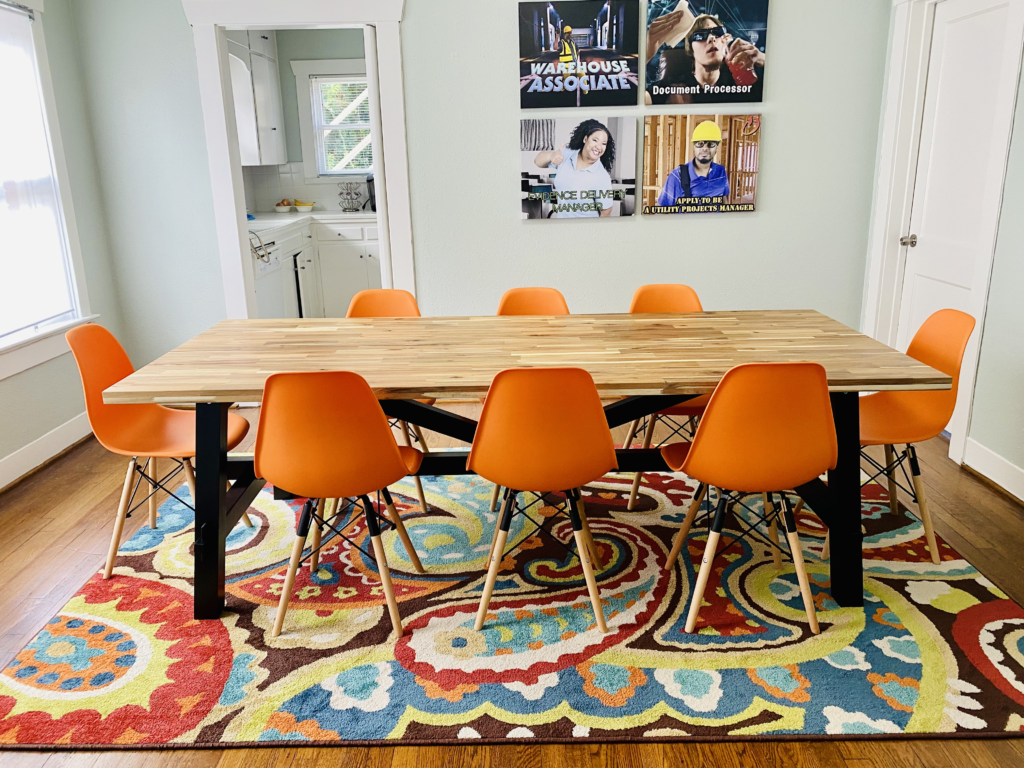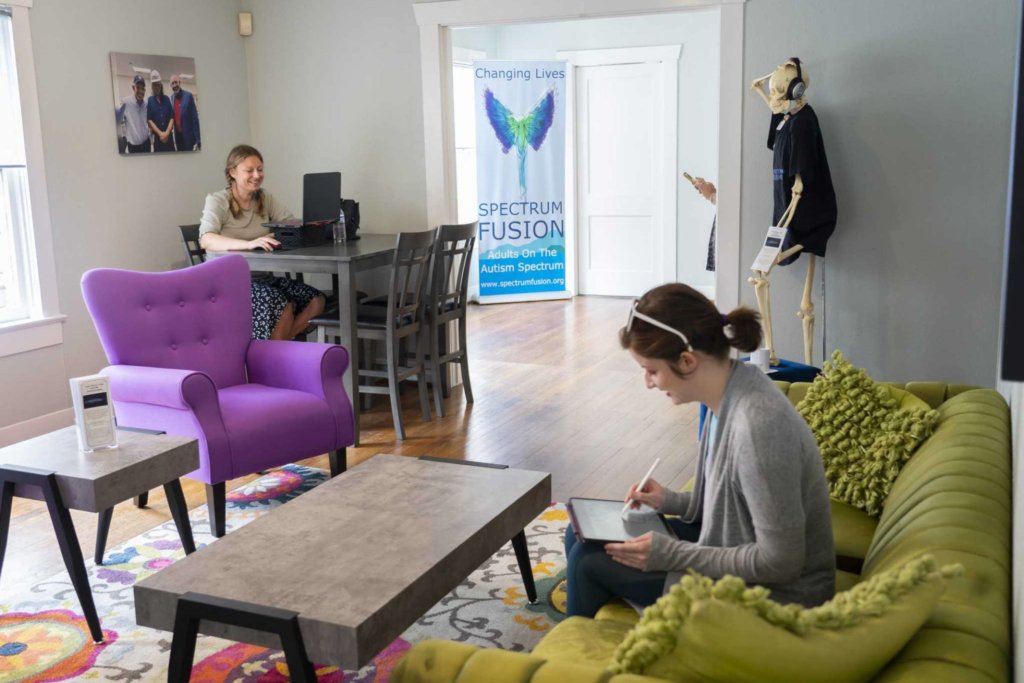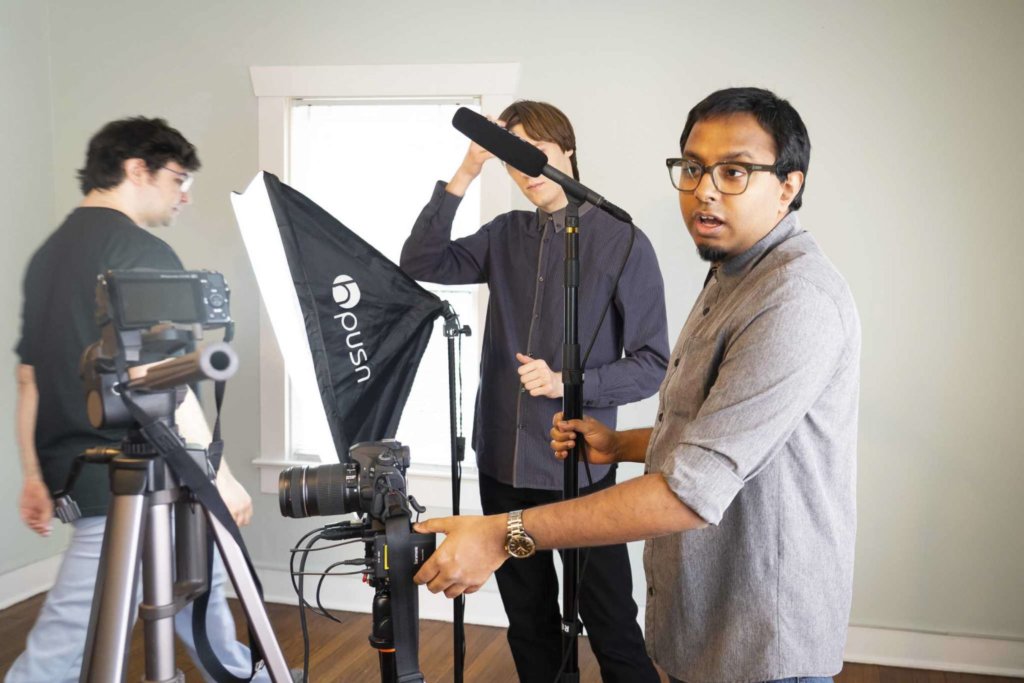
Spectrum Fusion has, since its inception, aimed to help foster safe and calming environments for adults on the Spectrum. This includes both social environments, where people can be free to express or not express themselves safely and without judgment, as well as in the physical environments our adults inhabit. In particular, keeping the latter in mind was especially important in how Heidi Ham and the other members of Spectrum Fusion sought to design and decorate the new building in the days leading up to the grand opening. With Spectrum Fusion hiring more and more adults on the autism spectrum, it was paramount to help create a soothing and relaxing working environment for our adults with autism.
Stimulatory issues are incredibly common in many workplace environments. Many factors that neurotypical employees would overlook, such as lighting, acoustics, how space is used, decor, and the furniture and other items within the workspace, can prove incredibly distracting or even distressing to adults on the spectrum. Overstimulation from the surrounding environment can cause adults to feel stressed or anxious, harm work performance, or even lead to public emotional meltdowns. We at Spectrum Fusion have worked hard to sidestep these issues and foster a physical environment that will ensure that our adults on the spectrum can feel the peace and comfort that they need in order to work efficiently and happily.
Imagine this: an adult on the autism spectrum sits in a cubicle. Their workspace is very small and cramped, with little room to move. Their office chair is stiff and uncomfortable, and the rough fabric of the meager cushioning scratches against their skin. The walls are low enough for people to peer over them and watch them, leading to a sense of paranoia as they wonder if they’re being silently judged. The fluorescent lights are bright and extremely overbearing, with an ever-so-slight flicker and hum that neurotypical employees can easily ignore, but seem like a buzzing strobe light to the employee with autism. The bright, white-painted walls reflect that very same light, causing the whole room to have a blinding glare. Talking and laughing coming from every direction. Phones ringing. Printers and computers beeping and buzzing. The nearest break room is down a long, winding hall on the other end of the building and if they were to try to escape to it, they would be forced to walk past everybody else in the office. Everybody would see them abandoning their work and judge them for it. And even if they should reach the break room, it will inevitably be filled with other employees, chatting, laughing, and judging. It’s all too much for our adult on the spectrum. They cannot function with all of this overstimulation.

Situations like this deeply affected our participant, Michelle Vines, in some of her previous workplaces. An adult with autism, Michelle’s job in the oil and gas industry was not accommodating at all and her employers refused to change anything.
“I felt awful and just needed to get out of there for reasons I never understood until I was diagnosed” says Michelle.
Situations like this are distressingly common, and most of our participants at Spectrum Fusion have a horror story or two of workplaces that seemed to drive them to the brink of meltdown. Unfortunately, while there can be many benefits and upsides to hiring adults on the spectrum, failing to create a proper environment for them to flourish in often means that those benefits are never seen. This leads employers who refuse to accommodate their employees on the spectrum to falsely believe that people with autism are lazy, incompetent, or far too fragile to make good employees. In reality, though, they are attempting to grow orchids in barren, sandy, desert soil, and then blaming the flowers when they fail to bloom.

The new Spectrum Fusion Studios office has created a space where adults with autism can thrive and work comfortably. “We’ve created an extremely happy, amazing place,” Ham said. “It doesn’t look like a corporate setting; it looks professional, but it has a very upbeat feel to it.”
Once adults with autism enter, there are no constantly ringing phones or crowds of people talking and laughing anywhere. No cramped cubicles or garish color schemes or buzzing fluorescents. Instead, the office is quiet, with open, inviting spaces that have calming colors on the walls but bright and creative collaborative spaces that lend themselves to creative brainstorming.
We have taken lighting, spatial planning, decor and design, and acoustics into the setup of the office space. In the case of lighting, as previously implied, bright fluorescents are highly discouraged when designing autism friendly spaces, and we chose softer lighting. The 2400 square foot building is flooded in natural light with nary a fluorescent bulb to be found at Spectrum Fusion. The many windows allow for soft, natural lighting to filter in and the feeling changes throughout the day. And should the light of the sun get too bright, all windows in the building are equipped with venetian blinds to control the brightness of the room. Furthermore, all ceiling lights in the building use soft, LED bulbs, surrounded by frosted glass to better soften and diffuse the lighting.

Regarding spatial planning, every room in the Spectrum Studios office comes with a defined purpose. Whether it be the “media room,” where most of the media team employees work to create video projects, the break room right next door where our employees can decompress and relax, the filming room where projects are actively recorded, or the conference room where meetings are taken, every room has its own strictly defined purpose. According to Daniel Joly who himself is a participant at Spectrum Fusion, this sort of design is easier for the autistic mind to process, and reduces the confusion and pressure that comes with not knowing what to do or where to be. Likewise, all of our rooms have spacious, open designs should our employees feel the need to move around or pace, reducing any sense of claustrophobia.
There are also multiple different working spaces in the building. Some employees don’t mind working with teammates in the same room, but others prefer to work in their own space. The Spectrum Fusion office has different types of rooms that accommodate both types of individuals. The media room, for example, is a collaborative room where members of our media team can work together and support each other. Meanwhile, other employees, such as marketing manager Adam Butts or the aforementioned Michelle Vines, prefer to work alone without distractions. These particular members have been granted their own dedicated spaces to work in.
Hand in hand with spatial planning comes decor and design. When designing our office space, we at Spectrum Fusion sought to avoid overstimulating colors or objects that might make the environment stressful. Bright colors, while perfect for colorful playrooms, can be straining on the eyes, may be overly exciting, and may cause discomfort when too much time is spent around them. Likewise, brown, black, and dark gray colors can make a space feel cold and oppressive, so they make for poor options as well. Sidestepping all of this, the walls of the Spectrum Fusion Studios office are painted a soft, calming shade of blue-green known as “sea salt.” Dr. Heidi Ham and the media team weighed numerous options before settling on this particular color, which is known to be a soothing shade that is neither too bright, nor too dark, and does not stand out exuberantly. It is a very pale combination of greenish blue and beige that does not try to grab your attention.

Our work to create a soothing and relaxing space extends to the choice of furniture and other decoration as well. For example, most furniture used in the office is fairly light and easily moved, save for a few tables and couches. This allows the space to be modular if necessary, as again recommended by Daniel Joly. If, for whatever reason, an employee feels the need for a space to be more open for a while, most chairs and other furnishings in the building can be easily moved around to allow for that. Furthermore, outlets like the Houston Chronicle point out that adults on the spectrum tend to largely prefer soft velvety fabric textures over coarser ones. To wit, the majority of our upholstery and pillows were specifically chosen to be soft and inviting, rather than scratchy or rough against the skin.
Finally, regarding acoustics, employees were invited to bring along their own earbuds or soundproof headphones, and are encouraged to listen to soothing music if they feel it necessary.
The Spectrum Fusion Studios office is shaping up to be a great place for adults with autism to work. A space where people are not constantly overstimulated or stressed out is the best space to grow and cultivate the skills and experience necessary to truly reap the benefits of a neurodiverse workforce!
Some photos courtesy of Houston Chronicle.






